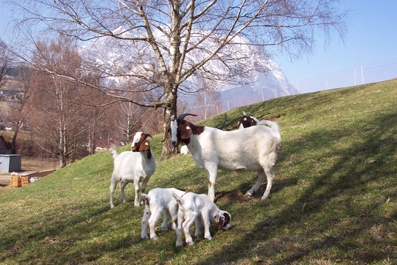This experiment aims to clarify the question of what the fattening and slaughter performance of animals weighing 30 or 42 kg is like and how the taste of the meat is influenced. Male Boer goats and castrated Boer goats are compared. The second question addressed is the crossing of white noble goats with Boer goats. Goat milk production is also an increasing branch of the business. If the breeding market is saturated, it may make more sense to cross the dairy goats with a meat goat in order to achieve better fattening and slaughtering results for the fawns. Male and castrated animals with a slaughter weight of 30 and 42 kg, respectively, are also compared in the F1 crosses.
Experimental execution
experimental animals
The Boer goats are purchased from state breeding farms, the F1 animals come from the herd at the LFZ Raumberg-Gumpenstein. Since the animals are crossed seasonally (once a year in spring), two rounds are carried out. The animals are housed with a live weight of approx. 15 kg. When they are housed, all animals are dewormed and their claws treated.
Experimental groups
Based on the question, there are 8 experimental groups. There are 5 animals in each group per round. The following table summarizes the experimental groups and the number of animals per group.
Experimental groups and number of animals
Boer goats F1 crosses
male castrated male castrated
30kg 10 10 10 10
42kg 10 10 10 10
Keeping and feeding the animals
The animals are kept in individual boxes on straw bedding. Feeding takes place twice a day. Hay, grass silage and concentrated feed are fed. Hay and grass silage are offered for free consumption, concentrate feed is rationed. The grass silage is given during the morning feeding, and in the afternoon the rest of the grass silage is weighed back and hay is fed. The concentrated feed is given in the afternoon before hay feeding.
The amount of concentrated feed depends on the live weight and amounts to 2.5% of the LG. The animals are weighed weekly and the amount of concentrated feed is adjusted weekly accordingly.
Composition of concentrated feed
|
Feed |
% in the mixture |
|
barley |
40 |
|
Dried schnitzel |
35 |
|
Soy extraction meal |
23 |
|
Mineral mixture for sheep |
2 |
|
201g XP, 12.6 MJ ME, 7.4g Ca, 5.6g P |
|
Data collection
mast performance
To determine the fattening performance, the daily DM intake is determined. A weekly bulk sample is collected from the initial weighing and the return weighing for chemical feed analysis. Live weight is determined by weekly weighing.
2.4.2 Slaughtering performance
After reaching the final fattening weight, the animals are slaughtered after fasting for 24 hours. The fasting weight, the carcass weight warm, the skin weight, the blood weight, the weight of the forestomaches and the empty abomasum are determined. The pH value is measured one hour and 24 hours after slaughter.
After the carcass has cooled for 5 days, it is cut into pieces. A sample is taken from the loin for the organoleptic test of the meat quality. The left leg and left shoulder sections are roughly broken down into meat, fat and bone.
For the chemical analysis of the meat for DM, crude fat, crude protein, crude ash and fatty acids, meat and fat are removed from the sirloin.
For the organoleptic examination, the loin meat is grilled without any additives and rated from 1 to 6 for tenderness, juiciness and taste.
Further information on project management can be found in the database for research and sustainable development (Dafne) -> Link







